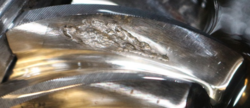Investigation of the Load Carrying Capacity of Bevel and Hypoid Gears with an Increased Bainite Percentage
Research Topic
| Short Title | Austempering of Bevel Gears |
| Start of Project | Q1/2020 |
| Funding | FVA-Nr. 513/V, IGF-Nr. 20953 N Federal Ministry for Economic Affairs and Climate Action, BMWK |
| Project Partner | Leibniz-Institut für Werkstofforientierte Technologien, IWT |
| Contact | Dr.-Ing. J. Pellkofer |
Project Description
Due to constantly increasing power density in the drive train, bevel and hypoid gears are subjected to a wide variety of mostly high stresses. In most applications, highly stressed gear components are case hardened to achieve a strength adapted to the load. Austempering is an alternative to conventional case hardening for gears. In IGF project No. 17903 N/2 "Randschichtgefüge" (“Boundary Layer Structure”) [Sad17], bainitized spur gears were used to determine the potential for increasing the pitting load carrying capacity while maintaining the tooth root load carrying capacity in the fatigue strength range and increasing the load carrying capacity in the fatigue strength range compared to case-hardened spur gears.
Within the scope of the proposed project, these advantages are to be transferred to bainitized bevel and hypoid gears and their load carrying behavior investigated. In this context, process limits of application austempering with regard to design, dimensions and alloy are to be identified and dimensional and deformation behavior of the heat-treated components are to be analyzed. Using the FZG hypoid back-to-back test rig, standard-capable strength parameters are to be determined with regard to load carrying capacity. In addition, these form the basis for reviewing and, if necessary, adapting existing calculation methods and for classifying them in the state of the art.
The intended results suggest an increase in the performance of bevel and hypoid gears. The strength properties determined and their classification in existing calculation methods for gear dimensioning, as well as the findings on the influence of individual material and heat treatment parameters on decisive gear damage, can be used directly by gear manufacturers or heat treaters (especially SMEs and the automotive industry) and implemented in industrial practice. This provides a means of increasing competitiveness.
Literature
[Sad17] Saddei, P.; Schurer, S.; Güntner, C.; Tobie, T.; Steinbacher, M.: IGF-Nr. 17903 N/2 - FVA-Nr. 513 III: Randschichtgefüge - Alternative mehrphasige Randschichtgefüge beim Einsatzhärten zur Steigerung der Festigkeitseigenschaften von verzahnten Getriebebauteilen, Heft 1248, Forschungsvereinigung Antriebstechnik e.V, Frankfurt/Main (2017).
